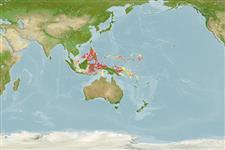Classification / Names
Common names from other countries
Main reference
Size / Weight / Age
Max length : 7.5 cm TL male/unsexed; (Ref. 9760)
Environment
Marine; demersal
Climate / Range
Tropical, preferred ?
Distribution
Short description
Dorsal
spines
(total): 5 - 6;
Dorsal
soft rays
(total): 7-9;
Anal
spines: 1;
Anal
soft rays: 10 - 12. Eyes large, diameter equal to interorbital space. Midlateral scale count 33-37. In preserved specimens, midlateral band's upper edge visible as lighter yellow-gold or black; the series of black dots on the scale rows extend as lines below the band.
IUCN Red List Status (Ref. 115185)
Threat to humans
Harmless
Human uses
Fisheries: of no interest
More information
Common namesSynonymsMetabolismPredatorsEcotoxicologyReproductionMaturitySpawningFecundityEggsEgg development
Age/SizeGrowthLength-weightLength-lengthLength-frequenciesMorphometricsMorphologyLarvaeLarval dynamicsRecruitmentAbundance
ReferencesAquacultureAquaculture profileStrainsGeneticsAllele frequenciesHeritabilityDiseasesProcessingMass conversion
Tools
Special reports
Download XML
Internet sources
Estimates of some properties based on models
Phylogenetic diversity index
PD50 = 0.5005 many relatives (e.g. carps) 0.5 - 2.0 few relatives (e.g. lungfishes)
Trophic Level
3.2 ±0.4 se; Based on size and trophs of closest relatives
Resilience
High, minimum population doubling time less than 15 months (Preliminary K or Fecundity.)
Vulnerability
Low vulnerability (23 of 100)
Price category
